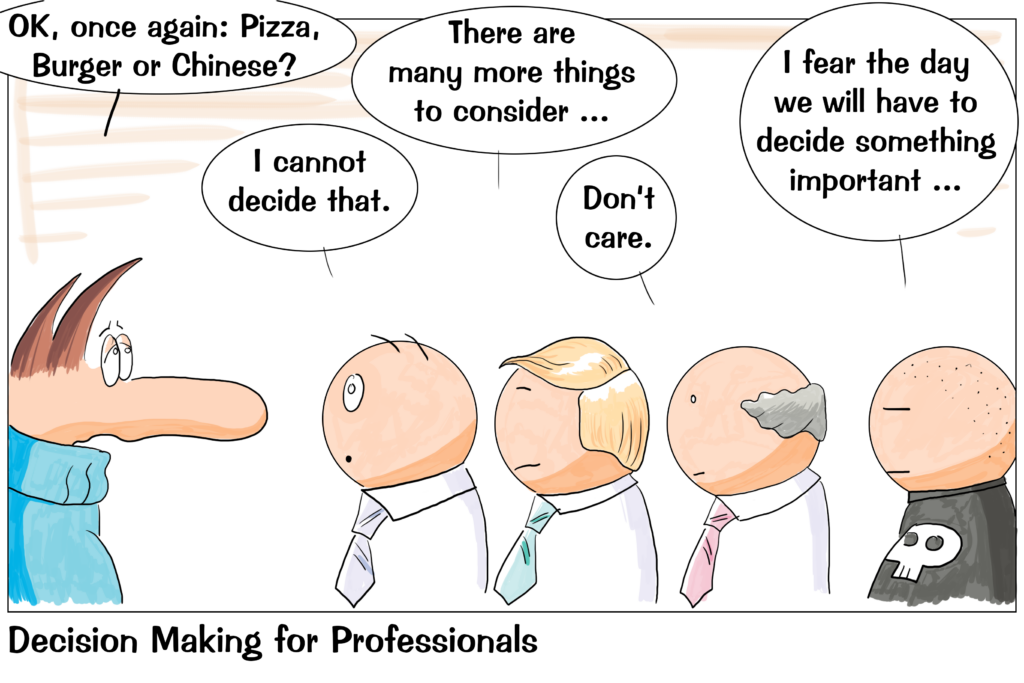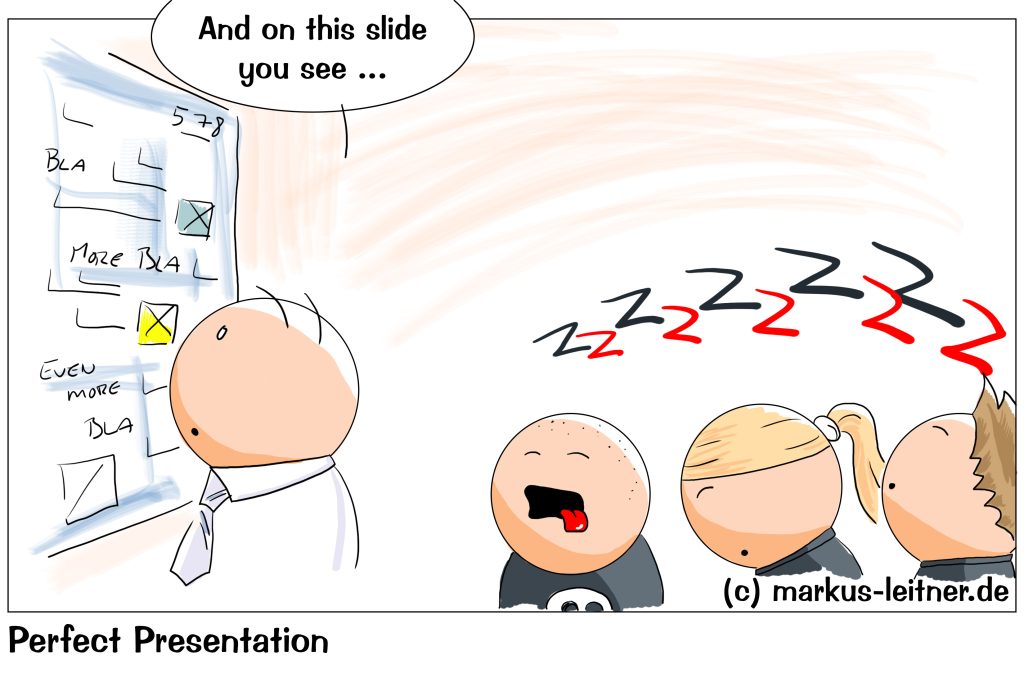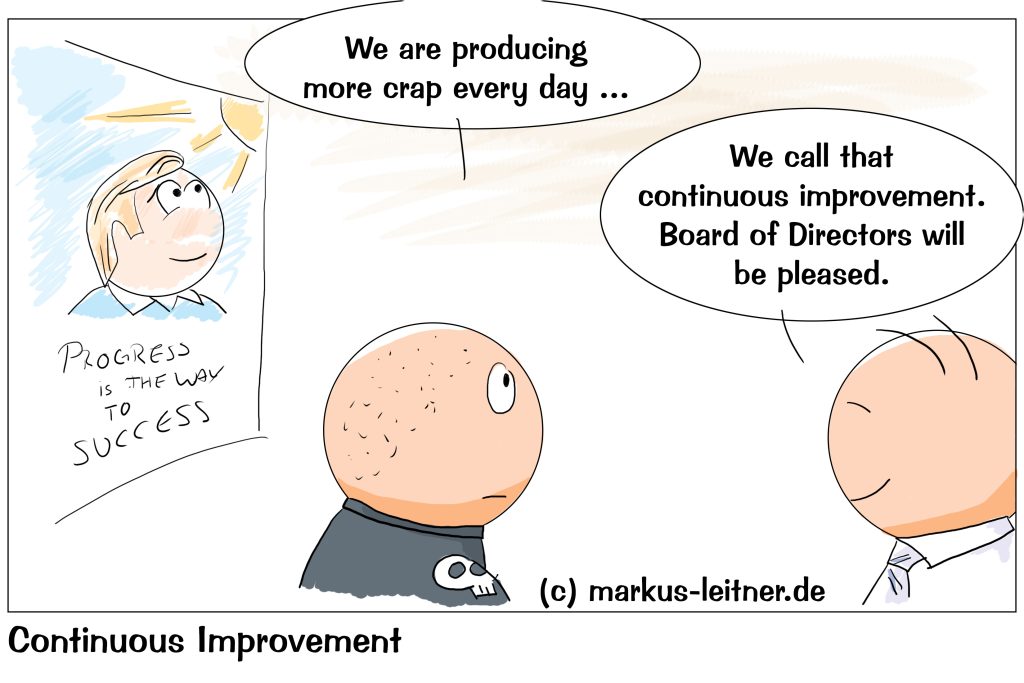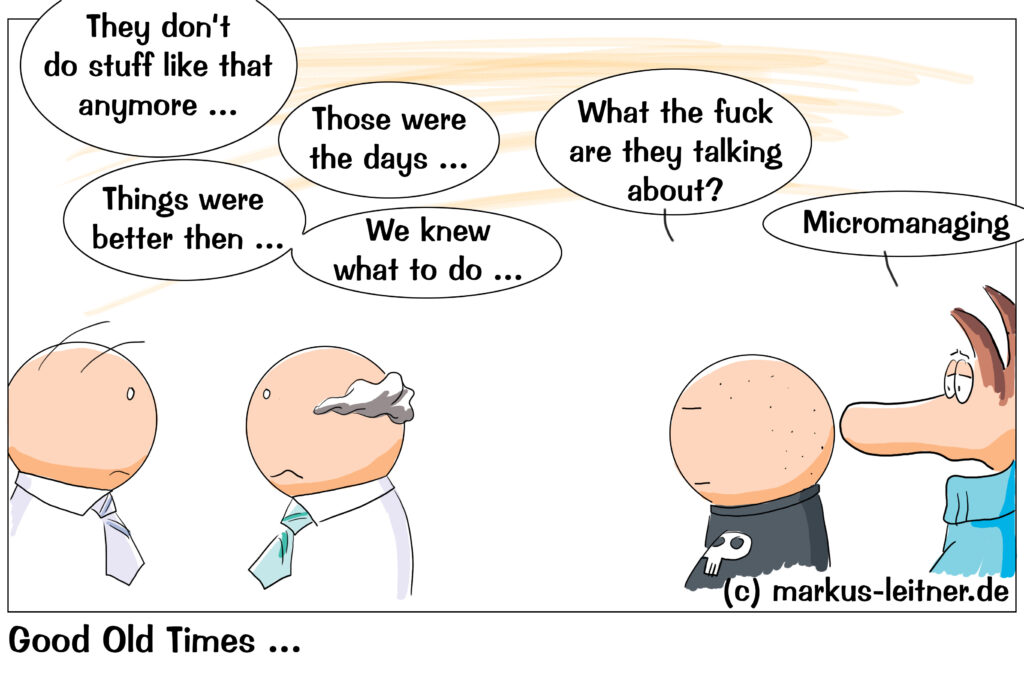
If our meetings do not seem to end, it is mostly because we are struggling to make a decision. Today we want to look at a very simple method for structured decision-making.
In the last part of this mini series we looked at the structure of decision-making-meetings and came to the conclusion, that the parts understanding, collecting options, evaluating, deciding and agreeing on the next steps, have to be clearly separated from each other.
Separation and structure will help us closing topics. If we do not do that, we will run in circles endlessly. You may be familiar with the situation, that everything seems to be ready and done, that we could now vote and be done with it, but then the endless repetition of everything, that has already been said, starts. That is exactly the moment, when you can watch one half of your colleagues doing everything to avoid a decision, while the other half slowly loses its will to live.
We get rid of this pattern with our structure, because we can just skip the repetition part. We have already said all that, everything noted here, vote please.
In the first part of the meeting, we have answered all understanding questions. Therefore, all members should be able to make a decision. Now it is time to collect our options. Sometimes some colleagues will already have prepared something, that they can now introduce to the others. As a moderator you write everything down, make it visible and make sure, that we do not start evaluating already. We do not want that now, and we do not need that now. Questions of understanding are fine, I am even fine with additions, but we do not want comments. You can stop those immediately.
Important: We are talking here about some clear problem with a hand full of options. We do not talk about those supergalactic topics, where we end up with 280 options after a ten-minute-brainstorming. With that kind of topic, you will need more clarification and another step of preselection before we get to the next part, our evaluation.
Now we need lots of room for writing, because we have to build a big table, where we write down our options in the left column. It is time for another round of collecting, when we ask the question: what are the properties or consequences of these options? We write those down, every single one in the same line as the option it stands for, field by field. Example: Option A is very expensive but will give us a lot of opportunities in the future. Those would be two entries: one property (expensive) and one consequence (opportunities in the future).
It is important, that we still do not evaluate or comment. We are still collecting. After that we will score every single item in our table. We are building a structure once again.
Option B might have an issue with data protection, for Option C we might lack some abilities. After a while our table will be filled, and we will find everything, that has been said. Therefore, there will be no reason to repeat anything. It also helps us to be more precise, because I will always have to ask: how can I write that down in two words?
We can be pretty sure not to speculate too much with our properties, but that might be something different with consequences. With those we will always also ask our glass sphere. You will notice almost immediately, if there is a fundamental agreement or if discussions start. If the latter is the case, I would ask, if consequences are unknown, and I would write exactly that. Unknown consequences are a risk. Therefore, that would be a property of this option: it bears a risk, because we do not know about the consequences.
You will also notice, when it is time to end our stage of collecting. When our colleagues are silent or start to repeat themselves, it is probably time to stop. We clarify, that we are still able to note further properties, but now it is time for scoring.
Bit by bit we give every property or consequence a score. We can and should keep that simple by using ++, +, o, -, –. There is no need to be too complicated. You can do the scoring like a planning poker, and that is actually a nice idea, because it prevents you from discussing every single bit, when we already agree. There is no need to explain, why we agree. A discussion only makes sense, if we do not agree.
Those discussions will be rare – trust me. A single property is very easy to evaluate and almost every time obviously good or bad.
Have we scored every single item (and you will be surprised, how quickly that is done, if we avoid long discussions, when they are not needed), we should ask, if one of the items with a negative rating is a killer. Meaning, that this particular negative property or consequence renders this option impossible. That might be an issue with data protection, that we can not avoid, for example.
That is very hard for many people, because they do not want to close something, we try to keep every option alive, but that will not help us. If it is clear, that there is a huge problem, that we can not avoid, this option is simply not possible. Full stop. No need for further discussions.
We can and should think about possibilities to avoid those killer consequences, but if we do not find a way, the option is not possible. We cross it out and do not talk any further.
Right now, we might have our whole wall filled and discussed everything there is to discuss. Everything has been said, and we can now vote. We should do exactly that: vote. We should not come to a decision by discussing once again. We should vote, and I do not care, if it is open or in secrecy, with simple or absolute majority. You can do as you like. As a moderator you will have something prepared. You make a suggestion and ask if there is anything that prevents you from doing so.
And then we vote.
If we evaluated every item on our wall, results will be most likely very clear. But if two options are almost equal, we can go into another decision round, why someone voted for what option, what property or consequence had more impact for a single person. And then we vote again.
The only reason to postpone our decision and our final voting would be, if we have the opportunity to get further information on some of our risks – the things, that we do not know. If that is not the case, we decide now. What could be different after another long discussion, when everything worth saying has already been said? What will be different after two weeks, when there will be no new information?
Exactly nothing.
With the winner of our voting, we ask, what will happen next. Who will do what until when? Is there a reason to come together again with the same group of people? What will happen next? We decide on things, that are verifiable, on clear tasks. A person or a group receives a task and commits to that. We do not close the meeting with a wishy-washy statement, or all of our previous efforts would have been in vain.
If you proceed like this, decision making will be much easier. All that may sound hugely complicated, but trust me: this structured method is way faster and more efficient than unstructured discussions.
Core: Every option has some clear properties and consequences, that can be evaluated. By doing that, by breaking options down, decision making is much easier, and a simple voting will do the trick.
If you need any assistance or want to know more, just speak to me.











